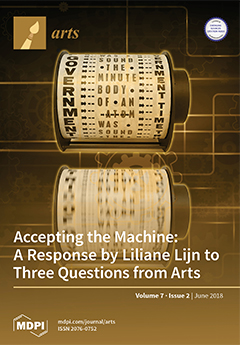Open AccessArticle
Choreographic and Somatic Approaches for the Development of Expressive Robotic Systems
by
Amy LaViers, Catie Cuan, Catherine Maguire, Karen Bradley, Kim Brooks Mata, Alexandra Nilles, Ilya Vidrin, Novoneel Chakraborty, Madison Heimerdinger, Umer Huzaifa, Reika McNish, Ishaan Pakrasi and Alexander Zurawski
Cited by 15 | Viewed by 8608
Abstract
As robotic systems are moved out of factory work cells into human-facing environments questions of choreography become central to their design, placement, and application. With a human viewer or counterpart present, a system will automatically be interpreted within context, style of movement, and
[...] Read more.
As robotic systems are moved out of factory work cells into human-facing environments questions of choreography become central to their design, placement, and application. With a human viewer or counterpart present, a system will automatically be interpreted within context, style of movement, and form factor by human beings as animate elements of their environment. The interpretation by this human counterpart is critical to the success of the system’s integration: “knobs” on the system need to make sense to a human counterpart; an artificial agent should have a way of notifying a human counterpart of a change in system state, possibly through motion profiles; and the motion of a human counterpart may have important contextual clues for task completion. Thus, professional choreographers, dance practitioners, and movement analysts are critical to research in robotics. They have design methods for movement that align with human audience perception; they can help identify simplified features of movement that will effectively accomplish human-robot interaction goals; and they have detailed knowledge of the capacity of human movement. This article provides approaches employed by one research lab, specific impacts on technical and artistic projects within, and principles that may guide future such work. The background section reports on choreography, somatic perspectives, improvisation, the Laban/Bartenieff Movement System, and robotics. From this context methods including embodied exercises, writing prompts, and community building activities have been developed to facilitate interdisciplinary research. The results of this work are presented as an overview of a smattering of projects in areas like high-level motion planning, software development for rapid prototyping of movement, artistic output, and user studies that help understand how people interpret movement. Finally, guiding principles for other groups to adopt are posited.
Full article
►▼
Show Figures




